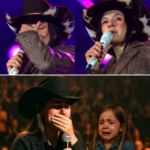A Tragedy in Bulacan That Left Not Just Ashes, but Unanswered Questions:
How Does a Mother End Up Killing Her Own Children? And Does She Still Deserve to Be Called a Mother?
Sta. Maria, Bulacan — Beneath a heavy sky and a deafening silence, two separate funerals were held on the same day. In one direction, the coffin of a woman — a mother — was lowered into the ground. There were almost no tears, just a tense stillness, as if everyone was holding back anger. In the other direction, three small coffins, surrounded by white flowers, were laid to rest — this time amidst the uncontrollable sobs of the father and grieving relatives.
This is the gut-wrenching aftermath of a crime that shook the entire nation: a mother, “Marites” (not her real name), set fire to herself and her three children inside their home. And while there are many lingering questions, one detail struck the public immediately: why were the mother and her children buried separately?
“I Couldn’t Bear to Lay My Children Next to the One Who Killed Them.”
These were the firm words of the father, Ramon, who is now struggling to rebuild his life in the wake of an unimaginable tragedy.
According to him, the decision to separate the burials wasn’t made out of rage, but out of principle.
“She didn’t just pass away. She killed my children. They no longer have a voice. I’m the only one left to protect their memory.”
Public Reactions: Sympathy or Outrage?
While many understood the father’s grief and fury, others questioned the choice to completely reject the mother — even in death.
🔴 “She was still their mother. Maybe she was struggling with depression, fear, or problems. Maybe we failed to listen.”
🟢 “What she did was merciless. She doesn’t deserve to be called a mother. The father’s decision should be respected.”
Social media erupted into debate. Comment sections were filled with emotional discussions: Was this society’s fault? Where was the support for mothers drowning in responsibility? Or was this purely a crime that deserved full condemnation?
A Portrait of Two Worlds
As the three young victims were being laid to rest, photos began circulating online of a different family — also with three young children. This one was a happy, lively family known for their joyful public presence, an influencer couple admired for their strong Filipino family values.
The comparison intensified public emotion.
“Look at them — both families with three kids. One is on a fun vacation. The other was burned alive by their own mother. Why does life turn out this way?”
Experts Weigh In: This Is More Than Just Anger
Mental health advocates and child welfare experts caution against ignoring the possible psychological state of the mother.
A mother doesn’t just kill her children without going through something deep. This isn’t an excuse — it’s a signal that we need to strengthen support for struggling mothers.
A Final Message Left Unspoken
Though the mother left no letter behind, a close neighbor recalled that days before the incident, she had said:
“Maybe when I’m gone, they’ll finally notice.”
A line that now haunts many — was it a cry for help? A curse? Or the last whisper of a mother who no longer knew how to ask?
Conclusion: A Secret, a Lesson, and a Voice We Must Not Ignore
No amount of anger can undo the loss of three innocent lives. No explanation can truly ease the pain of a father left behind. But one truth remains clear: many mothers in the Philippines are silently asking for help — for hunger, exhaustion, depression — but no one is listening.
This case should serve as a warning: let’s not wait until they kill or die before we notice, listen, and act.
As you read this, there may be a mother you know who is always quiet, always tired. Check on her. She might be the next one we’ll regret not saving.
News
Paul Soriano SHOCKS Fans with Shocking Revelation About Toni Gonzaga’s Transformation After Marriage
Filmmaker Paul Soriano shared candid revelations about his wife, Toni Gonzaga, and how their marriage has evolved over the years…
HAHA! THIS IS THE TRUE STORY OF JOYCE’S LIFE, LOVE AND MOTHERHOOD!
Behind her sweet smile and steadfast image, a deep and emotional story envelops Joyce’s life—a story that has just been…
KRIS AQUINO’S HEARTBREAKING HEALTH UPDATE: “Hindi Ko Na Kayang Labanan ang Sakit” — Family and Fans Hold On to Hope as Queen of All Media Faces Her Toughest Battle Yet 💔
MANILA — Isang emosyonal at nakapanghihinang balita ang gumulantang sa puso ng mga Pilipino: si Kris Aquino, kilala bilang “Queen…
SHOCKING REVELATION! COCO MARTIN EXPOSED BY FORMER STUNTMAN: Is His Kindness Just for Show?
In a shocking turn of events, a former stuntman has come forward to reveal what he claims is the “true…
Full Story of Mother Who Set Her Children on Fire in Bulacan – Tagalog True Crime Stories
Hindi maisip na lagim sa Bulacan: Ano ang nagtulak sa isang ina na sunugin ng buhay ang kanyang anak? Nabubunyag…
Lights, Camera… Scandal: The Year Fame Fell Apart🎬💢link in a comment section
There was a time when celebrities were untouchable — gods and goddesses of the screen, adored by millions, protected by…
End of content
No more pages to load










